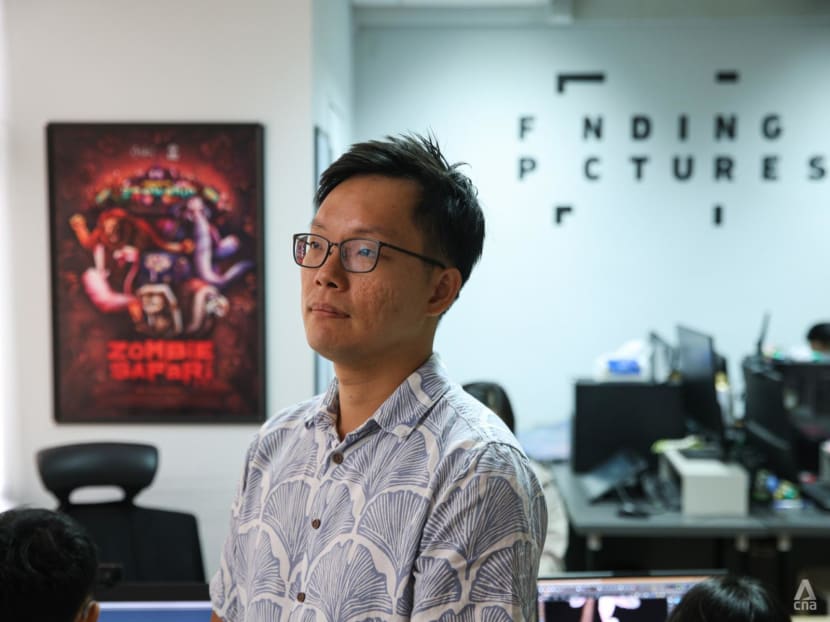The filmmaker who quit a safe teaching job to start an animation studio, winning global recognition
Before becoming a full-time animation filmmaker, managing a studio with four co-founders and a team of more than 10 artists, animators and illustrators, Mr Jerrold Chong was a teacher during the day and created films at night.

Mr Jerrold Chong (pictured) co-founded Singapore animation studio Finding Pictures, which did the animation for the music video of the 2021 National Day theme song The Road Ahead. (Photo: CNA/Nuria Ling)

This audio is generated by an AI tool.
For as long as he can remember, Mr Jerrold Chong, 34, wanted to be a filmmaker. The film bug bit him during his early teens and although most aspiring students might gravitate towards live-action films, he chose animation.
However, the path to giving life to his dream has been rocky.
After completing a prestigious animation course in California in 2016, he had to turn down a job at Pixar, probably the best-known large company in the world of animation.
"I was offered an internship for animation at Pixar after I graduated, but due to some scholarship constraints, I had to return (to Singapore) immediately," Mr Chong said.
"That's something that I still sort of look back on sometimes, on the 'what if'," he said, adding that some of his classmates had gone on to work on Pixar and Disney films.
Still, he now sees that missed opportunity as a blessing in disguise, because he went on to establish his own small studio called Finding Pictures, with some peers, rather than becoming a small cog in a giant global studio.
"The joy of being in Singapore and bringing all those ideas and knowledge here, setting up an independent community and your own studio … it's much more fulfilling than joining a big studio."
Through hard slog, sweat and tears, his self-made career and Finding Pictures have gained recognition at major film festivals, including Cannes in France.
The studio also broke new ground by doing the animation for the music video of the 2021 National Day theme song.
"I think what's special about my journey so far is I came back wanting to continue this independent practice as a filmmaker and to be able to do more."
For Mr Chong, animation has always been about creating stories by building a world of his own.
“A lot of craft goes into creating your characters. They could be fantastical, surreal or completely out of this world, and those stories appealed to me,” Mr Chong told CNA TODAY, his focused stare piercing through thin, rectangular glasses perched on his nose.
“There's also an element of magic to be able to not just create your own story, but within that, also create your world, your own set of characters.”
Before reaching this point of being a full-time animator-filmmaker running an animation studio with four other co-founders and a team of more than 10 artists, animators and illustrators, a more conventional career came first for him.
Mr Chong was an art teacher.
After returning from California in the United States, he would teach during the day and make films into the wee hours of the night.
On weekends, he was deep in the trenches of his craft, leading a double life constantly marked by exhaustion, passion and late-night animating in an industrial warehouse in Tuas, made available to him by one of Mr Chong’s artist friends.
“We would animate from 7pm until 2am,” he recounted. He explained in a firm tone that when animating a scene for stop-motion, “you must finish the scene”.
Any delay in filming the stop-motion sequence and the set could “shift” ever so slightly, whether from humidity, vibrations or an unnoticed nudge, thereby disrupting the entire sequence.
Stop-motion animation is physically manipulating objects in small increments between individually photographed frames, creating the illusion of movement when played in sequence.
Mr Chong works across multiple forms of animation, including stop-motion and 2D animation.

Unlike some live-action short films that can be shot in their entirety over a weekend, a 10-second shot in a stop-motion film can take him 10 hours to shoot, Mr Chong said.
When I asked which part of the process takes the longest, he said simply: “Animation takes the longest.”
There is no shortcut in animation. Every step, from storyboarding to animating to post-production, demands time, precision and patience.
It does not take much for me to do the sums, given that animated short films last from six to 40 minutes. For instance, a 10-minute film can take 6,000 hours to shoot based on 10 seconds taking 10 hours.
It may require more time if the sets are more elaborate and the characters have more complex expressions.
And that is just the time it takes to shoot the short. Editing and other finishing touches are another story.
For Mr Chong, though, all that effort is worthwhile.
“Many of my films are a little like parables or fables. That's where I think animation shines,” he said.
Indeed, one of his seminal works is the stop-motion short Piece of Meat, which uses paper cutouts to explore the themes of consumerism and class struggles through a sentient raw lamb chop in Singapore.
Piece of Meat premiered at the 2019 Cannes Film Festival Directors' Fortnight.
It was also selected at the 2019 Annecy International Animated Film Festival, also in France, on top of various other international film festivals. Annecy is the world’s premier animation festival showcasing top global animated films and shorts.
Earlier this week, as Mr Chong led me through the Finding Pictures workspace, it was clear that Piece of Meat remained one of his proudest creations.
He reached for a neon green file containing set pieces of Piece of Meat.
As he flipped it open, what fluttered out were hundreds of cutouts of lamb chops and champagne bottles at various stages of popping, together with other objects used in the film.
Sifting through the pieces, Mr Chong detailed the extensive work it took to bring the project to life, from photoshopping various elements onto the objects to painstakingly cutting out the many different sizes of all the "characters" of the film.
The path to pursuing the arts in Singapore is not a well-paved one. The route to becoming a full-fledged animator-filmmaker began almost as a side hustle for him and he described it as nearly a “guerilla” kind of animation squeezed into weekends and late nights.
It was only through countless rejections and relentless persistence that he and his co-founders mustered the confidence to carve out a space for filmmaking with animation in Singapore – one painstaking frame at a time.

BACKYARD ANIMATION AND SCRAPPY BEGINNINGS
On a sweltering Tuesday, I stepped into the studio tucked away in a nondescript building in Bugis.
The space hummed with intensity, punctuated by rhythmic keyboard taps, furious mouse clicks, flickering animation frames and the occasional whirr of rendering computers.
Animators sat hunched over laptops, some wearing headphones and windbreakers, brows furrowed in concentration. One animator had been adjusting how a petal fluttered in the wind for nearly 20 minutes, another meticulously refining the 3-D render of a fish.
The studio's walls were covered with the team's growing portfolio of work, from its short films to some of the studio's more ambitious ventures into animated series such as Puberteens and Zombie Safari.
Puberteens is a 16-episode 2-D series about teenagers navigating puberty, while Zombie Safari is a six-episode adult animated series about a zombie apocalypse that hits a zoo in Singapore. These two series were pitched to media company Mediacorp and are available to stream on its MeWatch platform.
What I was seeing was a far cry from the makeshift set-up of seven years ago, as described by Mr Chong.
"Many of us (the co-founders), during the first few years, we were teaching," he said.
It was a slow and steady marathon of building their work with each film, refining their craft and beefing up their portfolio.
Still, rejections were part of the routine.
"You can submit to 50 festivals, and 40 or even 45 will say, 'no'," he recalled.
Of the five acceptances, Mr Chong said that they provided a great experience, where he would fly to festivals and rub shoulders with more established animators in the business.
In those early days, "those little wins kept us and me going", he added.
"Being able to show very early short films in a local setting, getting that reaction from the audience and people connecting to your story, these kept us going."
The overwhelming response from audiences reinforced Mr Chong's passion, driving him to keep creating and, as he puts it, to "tell another story".
Fuelled by this momentum, he and his team committed to producing one short film a year, each project a meticulous process that demanded months of dedication.
Then, in 2018, Mr Chong and the team pitched and were successfully awarded their first paid commission from the National Gallery Singapore.
"We spent our most effort into a single pitch and spent three days doing a pitch," Mr Chong said, adding that they were usually fast, but this being a "first pitch" was particularly nerve-racking.
"Looking back, it was not a lot of money, but back then it was huge.
"We were barely even paying ourselves. So it felt like we were on the path to sustainability (for the business) and we got the idea that we could do this for a living."

Mr Chong said that rejection – and learning to accept it – is an inevitable part of a filmmaker's life.
So, in 2019, when Piece of Meat was selected for the Cannes Directors’ Fortnight, that email marked a turning point, bringing Finding Pictures into the spotlight and opening doors to further commercial projects.
"When the selection email came for Cannes, that really blew my mind," Mr Chong said, still in awe of that memory.
"I couldn't believe it," he added, referring to "the chance to travel to Cannes to watch the other films and soak up the atmosphere".
The Cannes Directors' Fortnight was more than just an opportunity to witness world-class cinema, it became a defining moment for him and Finding Pictures.
"It also provided a platform to showcase my work, that of the studio and, in a way, Singaporean animation on a global stage".
ON THE UP AND UP
By 2021, the studio's work had gained significant recognition, leading to one of its most high-profile projects yet: Finding Pictures was commissioned to create the animation for the National Day music video that year.
The COVID-19 pandemic was still underway and animation offered a "different perspective and approach", Mr Chong said. The team spent three to four months animating the sequence.
As with any project on one of the country's most significant days, he and the team were certainly under pressure.
"Even before the release, I was very nervous," he said.
"It was something that was tried for the first time. So even for us having this blend of live-action and animated characters together, that was something very new and I was also very uncertain about what the reaction would be."
The video, called The Road Ahead, intertwines real-world footage from Singapore with hand-drawn illustrations and motion graphics, where characters shift between different moments in Singapore's history.
After it aired, comments began to pour in on YouTube. Mr Chong and his team were both heartened and surprised to find that the feedback was filled with admiration.
Most comments praised their work, noting that they never imagined animation by Singapore creators could achieve such craftsmanship. The remarks affirmed the talent behind the project and validated the team's efforts.
Finding Pictures' success was not just a milestone. It affirmed that maybe Mr Chong's journey as a filmmaker was likely to be taking a different path from those of his schoolmates.
A key turning point for him after graduating from the prestigious California Institute of the Arts (CalArts) Character Animation programme was turning down an internship at the American animation studio Pixar.
It was the job that many of his classmates had dreamed of – the pinnacle of animation excellence. Turning it down was not easy and it stung.
"My CalArts friends were, of course, surprised, since no one usually passes on an internship with Pixar. It's like a dream studio for many of us," he said.
Mr Chong's friends and family in Singapore comforted him and helped him accept his disappointment about missing the internship due to scholarship constraints.
Looking back, he admitted that joining a major studio such as Pixar or DreamWorks once felt like the ultimate goal.
However, in hindsight, he realises that while it might have been a dream when he was a student, it could have easily become "a cog-in-the-wheel kind of experience".
"At that time, looking forward, I felt that my life and career in animation would take a different path than what I had planned or predicted."
It is a dilemma familiar to many young people in Singapore – the choice between stability and the pursuit of passion, often with little financial security.
Mr Chong is one of the rare few who has managed to turn creativity into a sustainable career. However, his success is still an exception, not the norm.
"I realised that perhaps my journey wasn't solely to be an animator in a larger studio," he said, noting that teams for a single film can be in the hundreds. It can take years before an animator can assume a lead role or direct a film of their own.
STILL AN UPHILL CLIMB
Even with all that the team has achieved so far, Mr Chong, like most in the creative field, is often struck by thoughts about whether the endeavour to pursue experimental work is "worth it" in Singapore and whether his "best work" is already behind him.
"It's constantly that internal voice of where my career or my filmmaking journey go. Is that going to be the best thing happening to me?"
He explained that Singapore is still a nascent animation market. Most people associate animation with children's cartoons or Japanese-style anime, and the medium has not yet reached the vibrancy of that in the West.
Therefore, creating independent art can be more challenging for animation filmmakers such as Mr Chong and his co-founders.
"(Singapore) is a tough environment to do creative work that we like and be sustainable because it's easy to sell out and do simple motion graphics and mass-scale art," he said.
"For us to retain that experimental mindset and creative vision, it's a lot of investment."
He also said that even if they were to pull out all the stops to release an animation feature, it might not be received well and prove unsustainable for the studio.
Mr Chong is fully aware that establishing an animation studio in Singapore is a rather risky and unconventional decision.
"Leaving teaching was certainly a pay cut," he said, noting that most Singaporean animators tend to choose stabler careers in video-game firms instead of animation studios or may even leave the field altogether.
However, Mr Chong and his co-founders at Finding Pictures are committed to playing the long game.
They focus on the bigger picture, creating work geared toward an international audience, working towards a full-length feature film and challenging themselves to create art that is profitable and aligned with their vision.
The latest feather in the cap for Finding Pictures is its showcase at World Expo 2025 in Osaka, Japan at the Singapore Pavilion, with Mr Chong leading the animation multimedia that the team has been working on for a year.
"We were approached early last year and I believe it was also the National Day music video that caught their eye," he said.
"It is very exciting to have this opportunity to use animation to showcase Singapore through more whimsical storytelling.
"What is heartening is that we can all come together and do something that we can show as a studio, as a Singapore animator. It's not something to be looked down upon. We can shine overseas."











